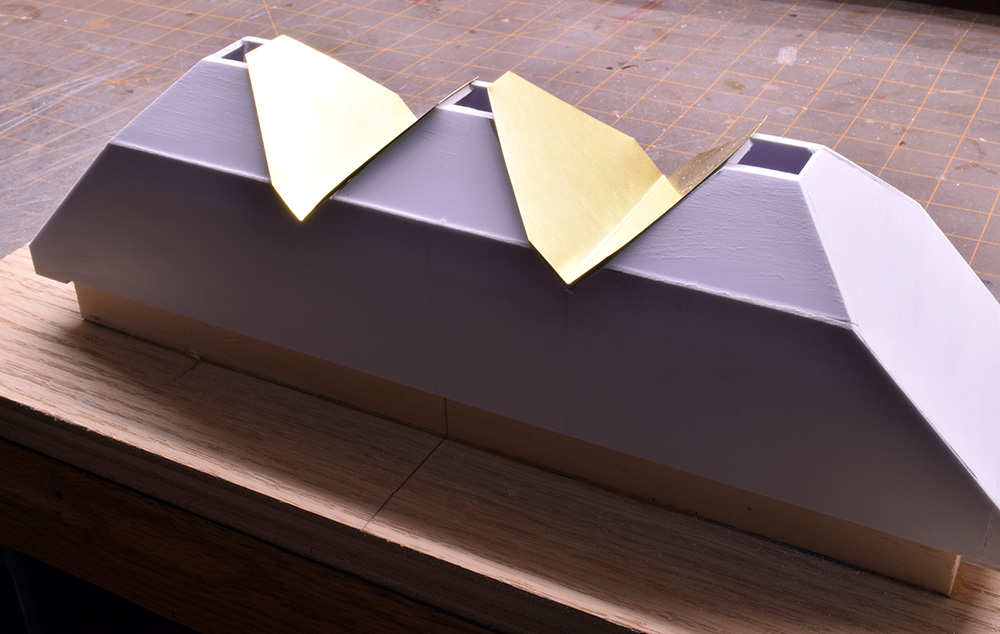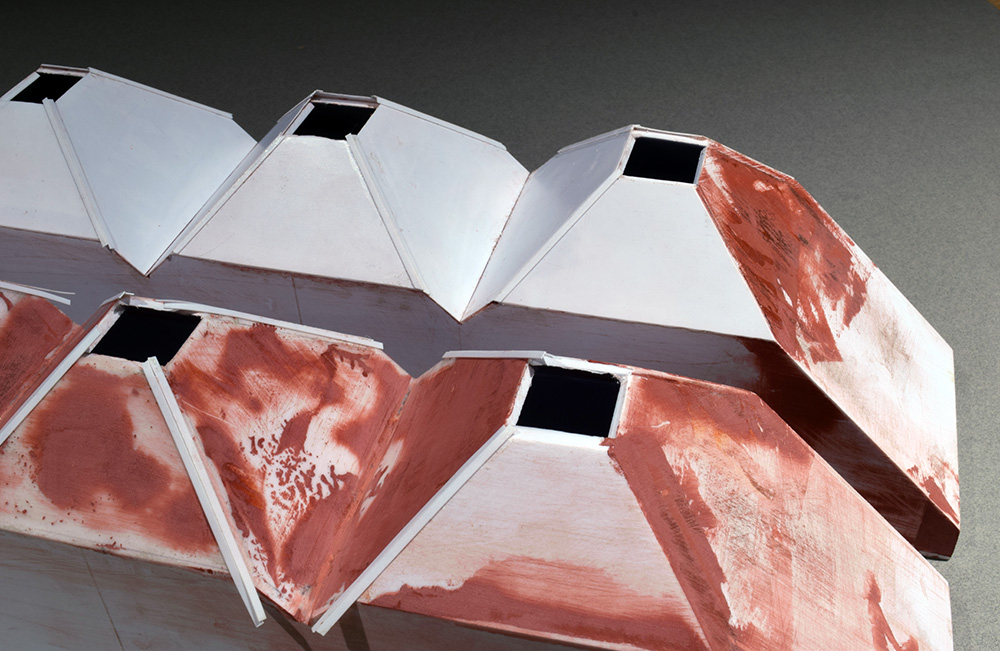I use my time at the bench to explore new ideas and challenge my own assumptions about the best techniques. I’ve had plenty of failures along the way and also had moments of triumph. Continuing the work on my covered hoppers, the bodies are ready for detailing.
As I did with the Pullman Standard boxcar from a few years ago, I plan to cover the styrene shells with 0.005-inch brass sheet. My objective is to replicate the visibly thin edge profiles of the full-sized cars. The sheet brass is more durable than styrene of the same thickness, making it an easy choice.

Using separate pieces gives a crisp seam at the junction where the chutes meet. It’s a bit of work to ensure the edges are clean and come together nicely but it’s certainly manageable. In experimenting with a single sheet, the initial fold wasn’t as sharp as I’d like. I’ve found that clamping the brass stock to my bench top with only the self healing cutting mat underneath doesn’t provide a hard enough surface for a clean bend. There’s just enough give in the mat to produce a rounded fold line. The result is very close to acceptable but not quite sharp enough to prevent problems with the pieces to be added later.
I switched gears and placed a small framing square under the brass sheet before clamping everything in place to make the fold. The metal surface of the square yielded the clean sharp line I was looking for, so I proceeded with the rest of the pieces. Evaluating the two methods, both would work and it comes down to a matter of preference. I like using a single folded piece, as it seems simpler and mimics the construction of the actual car. I also like knowing I have options to choose from.
Adding the rest of the brass sheets revealed more surprises. I cut each one a bit oversized so I would have some latitude in placing them before the gel CA grabbed, thinking I would just trim and profile the edges flush after the glue dried.
I’ve used this technique before with excellent results and I didn’t give it a second thought. This time however, something was different. The gel CA is the same brand I always use yet it would not form a solid bond on the brass sheets. Even after several days of drying time, I could easily peel them off the styrene core. I discovered this while trimming and filing the corner seams. Making a file stroke in the wrong direction would catch the edge of the adjoining piece and lift it. In analyzing the situation, I don’t know if the manufacturer changed the formula of the CA, if I missed a step or whether the basement chill affected the adhesive qualities. Regardless of the cause, the process wasn’t working.

The model in front has the sanding scratches and tool marks filled with auto body filler only. The one behind had the 0.005-inch brass stripped away and the CA residue sanded down as best as possible. Filler was applied, sanded and then a layer of 0.010-inch styrene sheet was glued on for the finished surfaces. The openings of the chutes have not been trimmed to their final dimensions yet.
The strips on each of the outside corners are 0.010″ x 0.060″ styrene. I’ll have more to say about them in the next post.
Back at square one again, I asked: What’s the advantage of using brass in this area? There wasn’t a compelling answer, so I decided to remove all of the brass and clean up the CA residue. I sanded it down as much as I could, then filled the remaining voids with auto body filler. Then I applied a layer of 0.010-inch styrene sheet for the finished surface. On the other core, the corner joints of the chutes are clean and tight. With a bit of wet sanding I could smooth them out and use the core itself as a primer ready finished surface (the one in the foreground in the photo above). Both techniques feel like the same amount of effort, so for me, it’s a question of which one produces the better outcome.
Many people would consider a setback like this a frustrating waste of time. I just refuse to think in such terms anymore. Discovering the solutions to problems like these is an enjoyable process for me. I like the deep dive into the work and exploring my options. In the process, I broaden my understanding and refine my observation skills in addition to my sense of commitment to the work. Real learning comes from within. Without that internal motivation to improve, it feels like I’m spinning my wheels in vain.
Regards,
Mike
“Increasingly, my real goal is to spend quality time in the quiet and solitude of my shop, exercising my creativity to produce models that are meaningful and satisfying.”
I love this. Selecting a project that will challenge your identity as a craftsman; challenging it to grow as it is ready to. In this way it doesn’t matter what you create so long as it supports the reason you’re at the workbench. In this way the work becomes meditative and at first results in a model but, in doing so, ultimately enriches the person. This is a wise use of time we can’t afford to waste.
Chris
“Many people would consider a setback like this a frustrating waste of time. I just refuse to think in such terms anymore.”
This. We don’t learn by doing everything “right” the first time. If we did, we would never discover new techniques.
Also, this is a hobby, not a job. Our enjoyment isn’t measured in terms of models produced/year. Everyone has their own thing they like to do and we should celebrate that.
Thank you both for the kind words. Welcome to the blog Steve, and yes we should be more respectful of differing opinions and approaches, sadly that isn’t always the case and I’m as guilty as the next person.
Mike